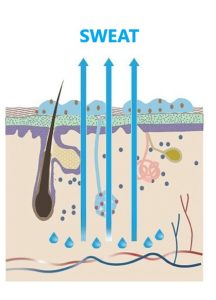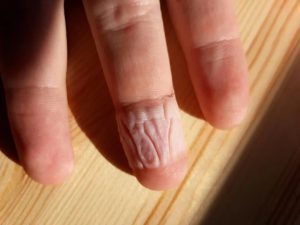Effective sweat management as a key factor for the medicinal patch success
José María Altinier –Galenic Development Supervisor
Introduction:
The effective management of sweat generated in the patch-skin interface, is a fundamental requirement in the design of a medicinal patch, to provide patients with safe and reliable products. Failure to comply with this requirement could cause problems ranging from compromising the effective adhesion of the patch throughout its period of use, to the appearance of side effects such as skin maceration.
The skin, like other organs of the body, has a significant presence of water in its structural composition and although we like to think of this organ as an unbeatable barrier that protects our body from harmful external agents, we must consider that there are processes in the skin of incorporation of substances, like the active ingredient absorption in a medicinal patch, or the release of corporal water, in the case of sweat.
Water circulates continuously from the deep layers of the epidermis to the surface, where it evaporates, giving rise to what is known as the process of perspiration. This process regulates the amount of water in the skin and is also related to the control of body temperature.
But what happens when we place a medicinal patch on the skin?
The presence of a medicinal patch on the skin could mean the creation of a physical barrier that could prevent the normal evaporation of sweat from its surface, leading to its accumulation in the patch-skin interface. The accumulation of sweat could cause problems in the function and the effectiveness of the patch as well as a safety issue for the patient.
One of the problems would be compromising the therapeutic efficacy of the medication by interfering with the contact between the adhesive surface of the patch and the skin (Interface), causing the patch to come off prematurely without having released the stipulated dose of active ingredient. Remember that medicinal patches have an adhesive matrix which has the function of adhering to the skin to release the active ingredient they contain. If effective adhesion cannot be ensured, the patch would be ineffective.
Another problem would be the skin’s reaction to the prolonged presence of moisture due to sweat. This adverse reaction is known as Maceration and is defined as the excessive accumulation of fluids in the skin that ends up generating wrinkles and a softening of the skin, which brings with it the risk of infection by losing its barrier function. The whitish color that the tissue takes on in this reaction is also characteristic. We can usually see this effect when using protective dressings on a wound or when using gloves made of occlusive materials (non-breathable) for long periods of time.
Can these inconveniences be avoided to ensure effective and safe products for patients?
The answer is absolutely Yes. During the design and formulation of a medicinal patch, a main objective for the product is to create an adhesive matrix with materials that have the capacity to manage sweat, avoiding its accumulation at the interface. Materials like acrylates or cellulose derivatives (hydrocolloids) make it possible to avoid the accumulation of sweat, as well as to ensure effective adhesion throughout the period of use of the medication.
After products development, these characteristics evaluated by clinical tests, ensuring that they comply with the highest quality standards of the most important health agencies in the world.
In this way, we can affirm that the effective management of sweat in the patch-skin interface is a challenge that must be understood and resolved by the professionals in charge of the design and development of medicinal patches in order to provide patients with safe and reliable products with proven efficacy throughout their useful life.
Subscribe to
#AmarinNews
Partner with us!
We offer expertise and experience, together with flexibility and the ability to adapt to your needs.
-
info@amarintech.com.ar
-
+54 11 4588-6500
- Sanchez 2045 (C1416BQG), Buenos Aires, Argentina.



